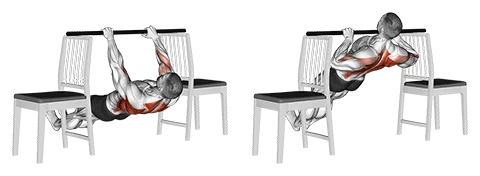Introduction
The "Inverted Row" is a bodyweight exercise that primarily targets the back muscles, including the latissimus dorsi and rhomboids. It mimics the pull-up movement but with your body in an inverted position, making it accessible to a wider range of individuals. This exercise is effective for strengthening the upper back, improving posture, and building functional strength, which is particularly beneficial for those aiming to increase overall back and shoulder muscle development, as well as reducing the risk of lower back pain and injury.
Muscles Worked
- Primary: Back (Latissimus Dorsi, Rhomboids, Middle Trapezius)
- Secondary: Shoulders (Posterior Deltoids), Core (Rectus Abdominis, Obliques)
How to Do It (Step-by-Step)
- Start by lying on your back with a barbell directly above your chest and hands shoulder-width apart. Your feet should be hip-distance apart and flat on the floor.
- Pull your shoulders down and back to engage your upper body muscles, then perform an inverted row by pulling the barbell towards your upper chest.
- Keep your elbows close to your body throughout the movement, and ensure that your core is engaged to prevent arching of the lower back.
Tip: To make the exercise easier, you can use resistance bands or have someone help hold the bar down for you. To increase the difficulty, try using a narrower grip or adding weight plates to the barbell.
Rep & Rest Guidelines
- Strength: 4–6 reps, 2–3 min rest
- Hypertrophy: 8–12 reps, 60–90 sec rest
- Endurance: 12–20 reps, 30–60 sec rest
Train smarter with Auto Progression. Optimize your rest periods using the Rest Timer.
Form Tips
- Maintain a neutral spine by engaging your core muscles and keeping your buttocks on the ground.
- Grip the bar with a wide, pronated (underhand) grip to minimize stress on the shoulders.
- Lower the bar by extending your elbows while keeping them close to your body. This helps maintain control over the movement and minimizes strain.
When to Use It
- For individuals looking to strengthen their upper back and improve posture, inverted rows are especially effective.
- Athletes seeking to increase pulling strength for sports like swimming or rock climbing can benefit from incorporating inverted rows into their routine.
- People with limited access to equipment at home or gym can use inverted rows as an alternative to a pull-up bar or cable machine.
Workout History helps you track your progress over time, ensuring you make the most of each workout scenario.
The inverted row primarily targets the back muscles, specifically the latissimus dorsi and rhomboids. It also engages the biceps and core.
Hang from a bar with an overhand grip, retract your shoulder blades, and pull yourself up to the bar, keeping your body straight. Lower slowly back to starting position.
A horizontal bar or TRX straps are commonly used for inverted rows. You can also use monkey bars or a power rack with a pull-up bar.
If you have shoulder problems, consult your doctor before performing inverted rows. If cleared, adjust the range of motion to suit your ability and avoid excessive weight.
Both exercises are beneficial, but they target slightly different muscles due to the angle of pull. Inverted rows can be a good alternative for those who struggle with traditional pull-ups.

